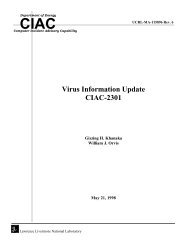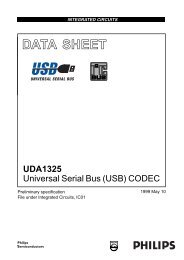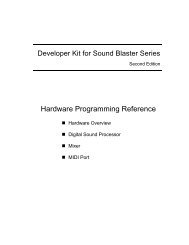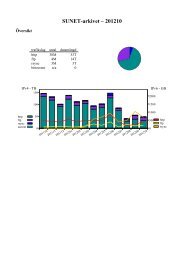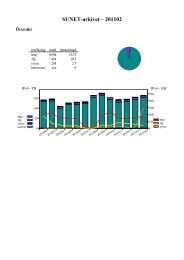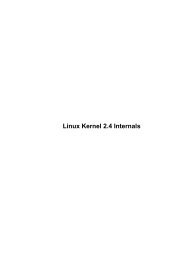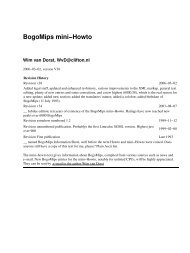Linux IP Masquerade HOWTO - The Linux Documentation Project
Linux IP Masquerade HOWTO - The Linux Documentation Project
Linux IP Masquerade HOWTO - The Linux Documentation Project
You also want an ePaper? Increase the reach of your titles
YUMPU automatically turns print PDFs into web optimized ePapers that Google loves.
•<br />
Testing patch pending/05_ECN−tcpchecksum−littleendian−fix.patch...<br />
Patch pending/05_ECN−tcpchecksum−littleendian−fix.patch applied cleanly.<br />
Applying patch pending/05_ECN−tcpchecksum−littleendian−fix.patch...<br />
Patch pending/05_ECN−tcpchecksum−littleendian−fix.patch applied cleanly.<br />
Excellent! Kernel is now ready for compilation.<br />
If everything patches fine, you should see something like the text<br />
Excellent! Kernel is now ready for compilation.<br />
towards the bottom of the screen. Beyond that, you don't have to install anything at this point. <strong>The</strong><br />
next step is to compile the new PATCHED kernel.<br />
• Ok, now the new kernel is ready to be compiled but you should make sure that you also have the<br />
proper matching iptables program on your machine too (just to make sure). Run the command:<br />
♦ whereis iptables<br />
and make sure its installed on the machine (the default place is in<br />
/usr/local/sbin/iptables. If you cannot find it or patched up your kernel sources as shown<br />
above, I recommend you just re−compile it up as shown above.<br />
Now that the kernel sources are patched up, you need to configure it to know what kinds of features you need<br />
(HD support, Networking support, MASQ support, etc.). Here are the MINIMUM kernel configuration<br />
options required to enable <strong>IP</strong> <strong>Masquerade</strong> functionality. Please understand that this <strong>HOWTO</strong> illustrates just<br />
ONE way to configure and compile a kernel (modules vs static). <strong>The</strong> main difference from this example vs. an<br />
example given by a different MASQ guide is that some people might wish to compile kernel components<br />
either as modules OR monolithically into the kernel. Basically, compiling things as modules gives you added<br />
flexibility to what is or isn't installed into the kernel (reduces unneeded memory use for things you aren't /<br />
won't use and modules also allow for drop−in software upgrades [usually no need to reboot the machine]). On<br />
the flip side, kernel modules add more complexity to your configuration and sometimes the kernel<br />
auto−loader might make mistakes (not that I've ever seen this happen). Compiling things directly into the<br />
kernel makes things simpler BUT you loose a huge level of flexibility. <strong>The</strong> following kernel configuration<br />
example is a mixture of both a selection of kernel modules and building them in monolithically (you probably<br />
will ALWAYS need MASQ functionality ready to go).<br />
• Side Note: It is assumed that you will also configure the kernel to use your other installed hardware<br />
such as USB printers, Ethernet network interfaces, SCSI and IDE HD controllers, etc. as well. Please<br />
refer to the <strong>Linux</strong> Kernel <strong>HOWTO</strong> and the kernel source's "README" file and "<strong>Documentation</strong>/"<br />
directory for detailed help on compiling a kernel.<br />
You will need to answer either YES, NO, or MODULE to the following program. Not all options will be<br />
available without the proper kernel patches described later in this <strong>HOWTO</strong>. This shouldn't be an issue as most<br />
3rd party patches are only needed for a very select group of users.<br />
Run the following commands to configure your kernel:<br />
• cd /usr/src/kernel/linux<br />
• make menuconfig<br />
<strong>Linux</strong> <strong>IP</strong> <strong>Masquerade</strong> <strong>HOWTO</strong><br />
Please note the following kernel prompts reflect a 2.4.14 kernel (with some of the optional Patch−O−Matic<br />
additions. Please read the following carefully for recommendations:<br />
Chapter 3. Setting Up <strong>IP</strong> <strong>Masquerade</strong> 19





